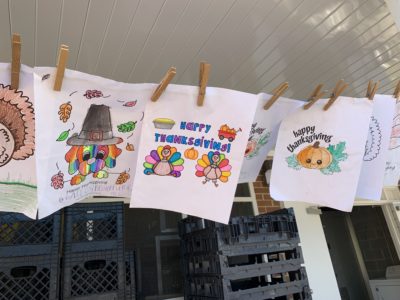
|
|
Last week, eligible K-12 students across North Carolina once again began receiving Pandemic Electronic Benefits Transfer (P-EBT), a food assistance program that loads benefits on EBT cards that can be used to purchase food at most major grocery stores. The program, which began in 2020 as a response to the COVID-19 pandemic, is designed to help families with children who are unable to access free- or reduced-price meals at schools because they are not physically in attendance due to COVID-19.
North Carolina is one of seven states approved to continue providing student P-EBT benefits during the 2021-22 school year, along with Indiana, Michigan, Minnesota, New Mexico, Ohio, and Wisconsin. The program is federally funded by the U.S. Department of Agriculture and administered in North Carolina through a collaboration between the Department of Health and Human Services (DHHS) and the Department of Public Instruction (DPI).
Since most schools have returned to in-person instruction and students can now receive meals in person, many families will not receive P-EBT this school year or will receive fewer benefits than in the past. However, the state applied to continue providing P-EBT benefits due to the fluid nature of responses to COVID-19, including quarantines, temporary closures, shifts to hybrid learning, and other actions that limit students’ ability to physically receive free- or reduced-price meals in person.
“Since the beginning of P-EBT, North Carolina has provided 1.3 million children with more than $1.73 billion in total food assistance benefits to help feed the state’s children,” said Carla West, senior director for economic security in the DHHS Division of Social Services. “North Carolina is proud to continue that mission into this school year.”
During the 2021-22 school year, the state estimates that P-EBT will provide roughly $153 million in benefits for 248,000 students.
Does my student qualify for P-EBT?
There is no application for P-EBT. Instead, benefits are automatically dispersed based on eligibility criteria. To be considered for P-EBT, students must:
1) Attend a school that participates in the National School Lunch Program (NSLP).
2) Be approved for free- or reduced-price meals.
If you would like to apply for free- or reduced-price meals, NC DHHS asks that you contact your child’s school directly. However, there are a few categories of students who automatically meet the second eligibility requirement of qualifying for free- or reduced-price meals:
- Students attending Community Eligibility Provision (CEP) schools, which serve school meals to all students at no cost, are automatically approved for free- and reduced-priced meals.
- Households that receive benefits through the Food and Nutrition Service (FNS) are automatically approved for free- or reduced-priced meals through direct certification.
- Students who are categorically eligible through circumstances such as homeless, foster, or migrant are automatically eligible for free- or reduced-price meals when the school knows of these circumstances.
This document lists whether or not schools participate in NSLP, and if they do, designates schools that are also part of CEP. Click here to search for your student’s school. Note that schools in purple participate in NSLP but have not met certain requirements for P-EBT and are therefore ineligible. Under a federal rule, virtual academies and home schools are not eligible to participate in NSLP and are therefore ineligible for P-EBT.
You can use this P-EBT eligibility flowchart in English or Spanish to check if your student is eligible.

My student’s school is on the approved P-EBT list and they qualify for free- or reduced-price meals. Now what?
If a student meets the two criteria listed above are met, they will receive P-EBT benefits based on their individual attendance record. Students must experience temporary virtual instruction and/or a quarantine period that prevents them from attending school in person. Schools determine if a student’s absence qualifies as a COVID-19 related absence and use special attendance codes to indicate this.
P-EBT provides $7.10 for each day a student spends in a COVID-19 related quarantine or temporary virtual instruction. Families who already receive EBT benefits will automatically receive P-EBT on their existing cards, while families who are new to EBT benefits will have a P-EBT mailed to their address on record. Those who previously received a P-EBT card will receive new benefits on that same card.
The state received approval to continue the P-EBT program for the 2021-22 school year in December 2021, so benefits for September, October, and November 2021 were issued retrospectively beginning last week. Moving forward, benefits will be issued retrospectively at the end of each month. For example, families of eligible students who missed school days due to COVID-19 in February will receive benefits by the end of March.
What can I spend P-EBT on?
The first step to using P-EBT benefits is activating your P-EBT Card. Here is information on how to activate your card and create a pin. Once activated, the P-EBT card can be used to purchase food at EBT-authorized stores, including most major grocery stores and online groceries such as Amazon and Walmart. Similar to EBT, also known as food stamps, hot and prepared food cannot be purchased with P-EBT. Here is more information on how P-EBT can be used.
What about younger children?
North Carolina is still waiting for federal approval of its plan to continue P-EBT benefits for children under 6 years old. This website will be updated once new information is available.
If you have additional questions, view the NC DHHS P-EBT FAQ page for more information.
Recommended reading




